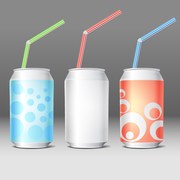 Vladimir Padalko/PhotoSpin
Vladimir Padalko/PhotoSpin
The New York Times reported that at the end of Summer 2011, 11 percent of the food items on supermarket shelves were labeled "reduced sugar". (5) We all think we’re making healthy food choices for our children if we find products that are low in sugar.
But the USDA estimates that the average American is supplied with 140 pounds of caloric sweeteners per year, working out to about 43 teaspoons for every man, woman and child every day (6). Some are starting to question which is the lesser of two evils --sugar or artificial sweeteners?
How do Artificial Sweeteners Work?
Artificial sweeteners are between 160 and 13,000 times sweeter than sugar meaning that only a small amount is necessary to get the same sweetness as normal sugar with the added bonus of fewer calories. (2)
Common kinds of artificial sweeteners include:
• Aspartame – NutraSweet or Equal
• Cyclamate – Sucaryl
• Acesulfame K – Sunett or Sweet One
• Saccharin – Sweet ‘N Low, Sugar Twin
• Sucralose – Splenda
When we eat something that contains sugar, our bodies release insulin to help our cells absorb the sugar, and serotonin which makes us feel good. When we eat foods containing artificial sweeteners, however, there is no insulin or serotonin release. (5)
The Argued Cons to Artificial Sweeteners
For some, once the body realizes it’s been cheated out of the feel-good results of eating something sweet, it may crave carbohydrates to satisfy that need. (5)
There have also been claims (and studies that both refute and support these claims) that overuse of or allergy/sensitivity to artificial sweeteners can result in symptoms such as:
• Hyperactivity
• Skin rashes
• Dizziness
• Numbness, diarrhea
• Muscle aches
• Headaches/migraines
• Interfere with good gut enzymes and digestion (particularly in relation to medication absorption)
How Can I Better Manage Sugar Intake?
In the end, the issue really is keeping our body energized while balancing blood sugar levels. Here are a few sugar control tips:
Sugar Control Tip #1: Safe Carbs
Our bodies need carbohydrates including sugars, for energy, but make sure this energy boost comes from starches (pasta, rice, bread, potatoes), which are also great sources of complex carbohydrates, vitamins, minerals and fiber (4) – nutrients which your body needs to help keep blood sugar levels balanced.
Sugar Control Tip #2: Read Labels
Watch out for added sugars. This includes white or brown sugar, as well as other less-obvious forms such as cane syrup, corn syrup, and glucose/fructose. You and your child may be ingesting more sugar than you think and, very likely, far more than your body needs.
Sugar Control Tip #3:Keep it Natural
Children should be taught to appreciate the natural sweetness of fruits and vegetables. “[B]abies who are fed only such foods grow up to shun the chemical taste of artificial sweeteners ... On the other hand, if your infant is fed a steady diet of artificially sweetened foods and drinks, he will grow up thinking this is what food if supposed to taste like.” (3)
Add cinnamon (which also has blood sugar balancing properties) or blueberries to yogurt as an option.
“Remember that moderate amounts of sugar, no matter what their source are part of a healthy diet” (4) and both sugar and artificial sweeteners need to be used wisely.
Sources:
1) Sweeteners. Cronier, Claire. The Canadian Diabetes Association. Web. Feb 6, 2013.
http://www.diabetes.ca/diabetes-and-you/nutrition/sweeteners
2) “Are Sugar Substitutes Safe?” Harvard Medical School. Web. Feb 6, 2013.
http://www.health.harvard.edu/healthbeat/HEALTHbeat_033005.htm
3) Ask Dr. Sears: Artificial Sweeteners for Kids? Parenting.com. Web. Feb 6, 2013.
http://www.parenting.com/article/ask-dr-sears-artificial-sweeteners-for-kids
4) Sugar & Artificial Sweeteners. Ask the Dietitian. Web. Feb 6, 2013.
http://www.dietitian.com/sugar.html#.URFdf2ckWSc
5) Sugar substitutes and the potential danger of Splenda. Pick, Marcelle OB/GYN NP. WomentoWomen.com. Web. Feb 6, 2013.
http://www.womentowomen.com/healthyweight/splenda.aspx
Reviewed February 7, 2013
by Michele Blacksberg RN
Edited by Jody Smith






Add a CommentComments
There are no comments yet. Be the first one and get the conversation started!